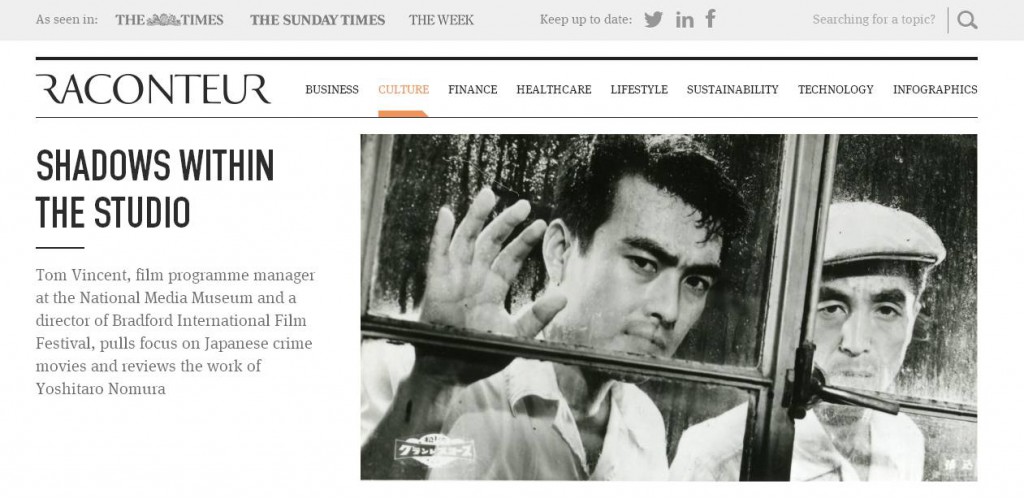I have been programming films here for eight years, and have often wondered about the affects that programming certain films can have on film culture and how film canons can change over time. As part of this year’s Bradford International Film Festival, I decided to programme some old films by a director who is completely unknown in the UK, and to then see how the films were discussed by audiences and critics.
The subject I chose was the Japanese studio director Yoshitaro Nomura. I selected five of Nomura’s films and wrote about them in the contexts of Japanese society and Japan’s film industry. Following the programme, which played at the Institute of Contemporary Arts in London, I was asked by the special interest publisher Raconteur to write on Nomura’s films for a general, culturally interested readership. Raconteur’s editors asked for an article that spoke about the ways the director used commercial cinema to incorporate themes that he saw as important and current in Japanese society—a sense that there was a kind of darkness in Japan that had been covered over in recent postwar history.
Read ‘Shadows Within the Studio’ at the Raconteur website
Yoshitaro Nomura is almost unknown outside Japan, where his films were popular in the 1960s and 1970s. I have found it really interesting to see how the films have taken shape in people’s minds, from having almost no prior knowledge beyond press releases and the notes for the festival catalogue.
Often when we go to retrospectives of film directors or actors, those people come with a certain reputation based on what has been written before. Not so with Nomura, and the chance to introduce his work in the UK has been a great pleasure. As well as my own article for Raconteur, there have been others by great scholars and writers.
Dr. Alexander Jacoby gives a career overview in his piece ‘Journeys Into Night: the police thrillers of Yoshitaro Nomura’. He identifies Nomura’s disturbing 1978 drama The Demon as possibly the director’s masterpiece.
In his Guardian article ‘The Demon – the film that breaks the last cinematic taboo’, Phil Hoad also notes the power of The Demon, and points to the fact that the film could only be the product of a particular time and place.
On the Global Film Book Blog, West Yorkshire’s own Roy Stafford wrote ‘Introducing Nomura Yoshitaro’, highlighting each of the programme’s five films as well as the combinations of genres on display in Nomura’s films.
Writing in the Times Literary Supplement, Adam Mars-Jones admired composer Yasushi Akutagawa’s scores for the films. Mars-Jones compared his work to both Bernard Herrmann and Micel Legrand, and said this combination helps explain how the films ‘can start hard-bitten and end up awash with emotion’.
I think one of the best things film festivals can do it to make a case that certain less well-known things in film are interesting. There’s so much undiscovered film history to draw on, especially films from Asia—for example, the cinema of China, India and Thailand all have great, lesser-seen pasts. I also think that a country’s commercial cinema, its thrillers, horror films and popular melodramas, can tell us a lot about that country, its neuroses, fears and hopes.
When we do look at these films, it almost always results in surprise and discovery. For example, until I watched Nomura’s The Shadow Within at the ICA and chatted with some of London’s Japan experts, I would never have learned that the film’s writer, Seicho Matsumoto, once came to the UK to research Stonehenge. There’s no evidence that this master of Japanese noir ever wrote about England’s mysterious prehistoric monuments, but I reckon that’d make a pretty interesting film!
For those interested in seeing Nomura’s films but who missed them in March and April, you can find English-subtitled DVDs of The Demon and Zero Focus at Amazon, and several other Nomura films at YESASIA and DDDhouse.
We are grateful to the Daiwa Anglo-Japanese Foundation and the Great Britain Sasakawa Foundation for their support for this programme.
